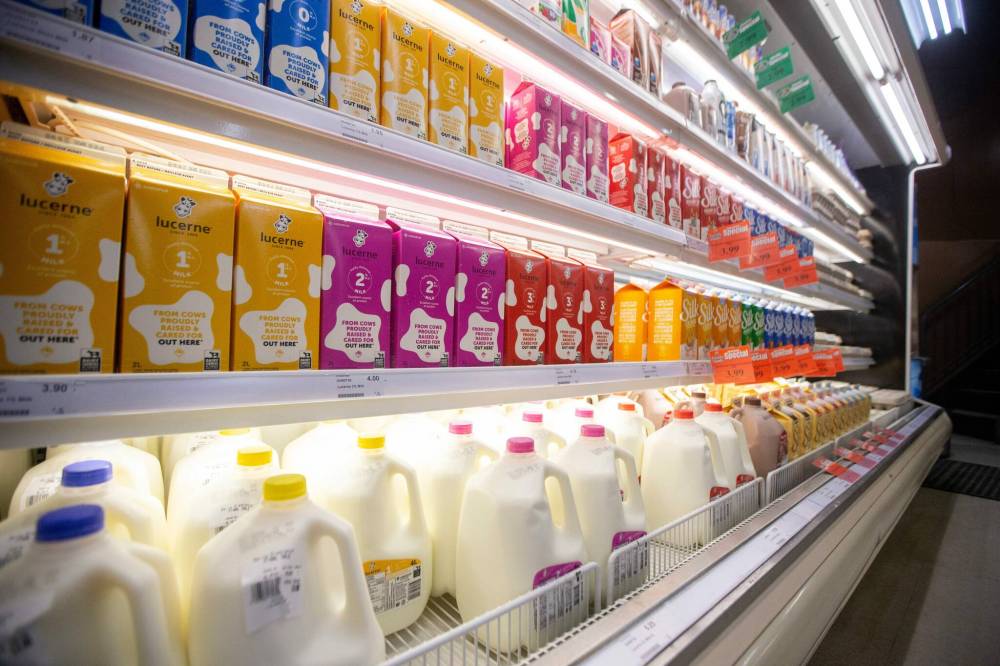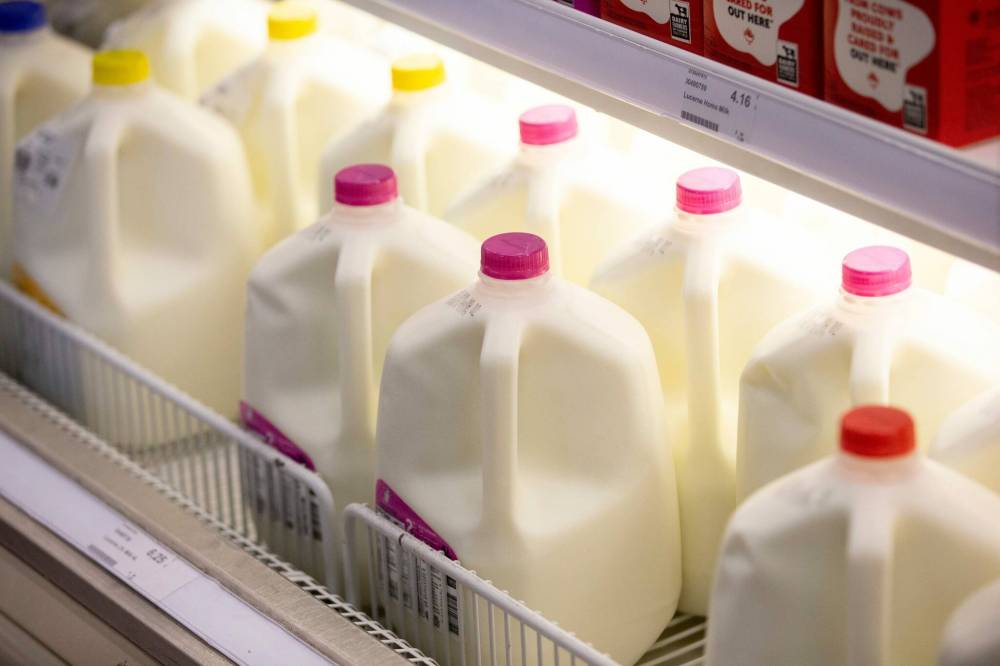Several factors cited as reasons for rising food prices
Advertisement
Read this article for free:
or
Already have an account? Log in here »
To continue reading, please subscribe:
Monthly Digital Subscription
$0 for the first 4 weeks*
- Enjoy unlimited reading on winnipegfreepress.com
- Read the E-Edition, our digital replica newspaper
- Access News Break, our award-winning app
- Play interactive puzzles
*No charge for 4 weeks then price increases to the regular rate of $19.00 plus GST every four weeks. Offer available to new and qualified returning subscribers only. Cancel any time.
Monthly Digital Subscription
$4.75/week*
- Enjoy unlimited reading on winnipegfreepress.com
- Read the E-Edition, our digital replica newspaper
- Access News Break, our award-winning app
- Play interactive puzzles
*Billed as $19 plus GST every four weeks. Cancel any time.
To continue reading, please subscribe:
Add Free Press access to your Brandon Sun subscription for only an additional
$1 for the first 4 weeks*
*Your next subscription payment will increase by $1.00 and you will be charged $16.99 plus GST for four weeks. After four weeks, your payment will increase to $23.99 plus GST every four weeks.
Read unlimited articles for free today:
or
Already have an account? Log in here »
Hey there, time traveller!
This article was published 20/04/2023 (965 days ago), so information in it may no longer be current.
Wholesale food prices may continue to rise in the coming years, leading to dramatic increases by 2025, Dalhousie University researchers project.
By 2025, retailers and distributors might pay an average 34 per cent more for wholesale goods than they did in 2022, according to a forecast Dalhousie University’s Agri-Food Analytics Lab released.
The Nova Scotia-based institution charted increases across food sectors over the three-year time span: 45 per cent in meats, 41 per cent in dairy, 35 per cent in bakery goods, 29 per cent in fruit and 42 per cent in “other,” which includes non-perishables.

MIKAELA MACKENZIE / WINNIPEG FREE PRESS
By 2025, retailers and distributors might pay an average 34 per cent more for wholesale goods than they did in 2022, according to a forecast Dalhousie University’s Agri-Food Analytics Lab released.
“We need to treat these numbers with caution,” said Sylvain Charlebois, the food analytics lab’s scientific director. “It is a forecast, and the longer you look ahead, the less likely it is accurate.”
The numbers are “frightening,” but it’s important Canadians know that price increases are continuing along the supply chain, Charlebois said.
Reasons for food price increases continue to be numerous. Charlebois cited climate change, supply chain issues, higher labour costs and new environmental policies, like the recent ban on single-use plastic manufacturing.
Kevin Schmidt continues to order higher priced produce, meat and dairy products at Downtown Family Foods.
Still, the grocery store owner’s main concern is the province’s minimum wage increases. The minimum rate jumped 65 cents to $14.15 on April 1 and is scheduled to reach $15.30 in October.
“That has to be covered somewhere,” Schmidt said. “Usually it’s the consumer that’s going to have to help with that, because we have no choice.
“We can keep taking on debt, and then there will be no grocery store downtown.”
Downtown Family Foods, and other grocers, might be doubly hit by wage increases, Schmidt said — he’s paying staff more, and he’s buying higher priced items from companies that might be covering their own employees’ raised wages.
“The people that suffer the most are the ones that make the minimum wage,” Schmidt said.
A 41 per cent increase in dairy product prices between 2022 and 2025 seemed steep to David Wiens, chair of the Dairy Farmers of Manitoba.
“I’m not experiencing what would push us up 41 per cent in a couple years’ time,” said Wiens, who farms near Grunthal.
Dairy farmers don’t set the wholesale prices. Even so, their operating costs contribute to the price tags on store shelves.
“We still continue to feel some of the inflationary pressure,” Wiens noted.
Labour costs and interest rates have jumped, but fertilizer and fuel prices have decreased from pandemic-era highs, Wiens said. The latter prices haven’t dropped to pre-pandemic levels, he added.
Dairy farmers have tried to manage rising costs through “efficiencies” on the farm, he said.

MIKAELA MACKENZIE / WINNIPEG FREE PRESS
A 41 per cent increase in dairy product prices between 2022 and 2025 seemed steep to David Wiens, chair of the Dairy Farmers of Manitoba.
Many hog producers are running on slim to negative margins, said Cam Dahl, Manitoba Pork’s general manager.
“We’re in a really uncertain period,” he said. “We’re facing almost record input costs.”
Global factors, like the African swine fever decimating pork populations in Asia, contribute to the industry’s uncertainty, Dahl said. Ukraine was one of the largest feed grain suppliers before Russia’s invasion; feed prices have since skyrocketed, he said.
Dalhousie University used machine learning — plugging data sets into artificial intelligence — to forecast the coming years’ food prices.
The projection showed an increase of 46 per cent in wholesale prices to restaurants.
“It’s not a great picture,” said Shaun Jeffrey, the Manitoba Restaurant and Foodservice Association’s CEO.
Food prices are beginning to “level out,” but the average restaurateur still sees slight increases. It makes planning for the future difficult, Jeffrey said.
“We would’ve hoped to see some decreases in pricing now, but it just isn’t the case,” he said.
Grocery prices were up 9.6 per cent this March compared to last. Meantime, Canada’s overall inflation rate slowed to 4.3 per cent. In Manitoba, the overall rate was 5.2 per cent.
Dalhousie University’s data project wholesale vegetable prices to increase eight per cent from 2022 to 2025. By then, Canada could be growing more of its own produce, Charlebois said.
gabrielle.piche@winnipegfreepress.com

Gabrielle Piché reports on business for the Free Press. She interned at the Free Press and worked for its sister outlet, Canstar Community News, before entering the business beat in 2021. Read more about Gabrielle.
Every piece of reporting Gabrielle produces is reviewed by an editing team before it is posted online or published in print — part of the Free Press‘s tradition, since 1872, of producing reliable independent journalism. Read more about Free Press’s history and mandate, and learn how our newsroom operates.
Our newsroom depends on a growing audience of readers to power our journalism. If you are not a paid reader, please consider becoming a subscriber.
Our newsroom depends on its audience of readers to power our journalism. Thank you for your support.


